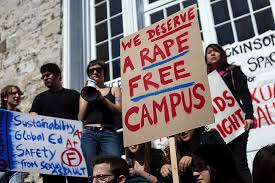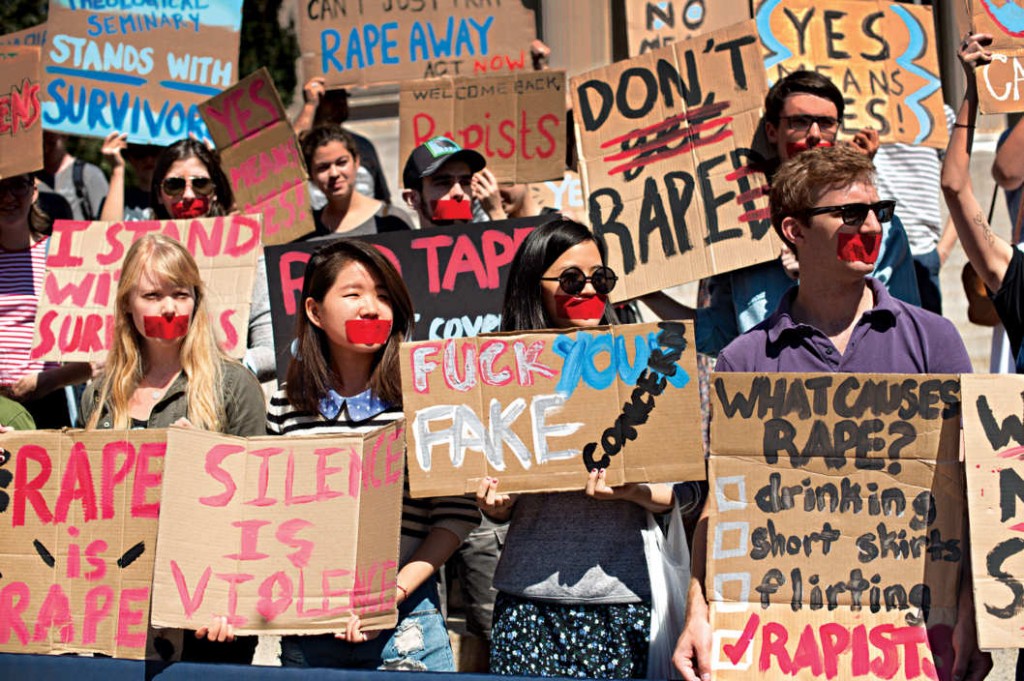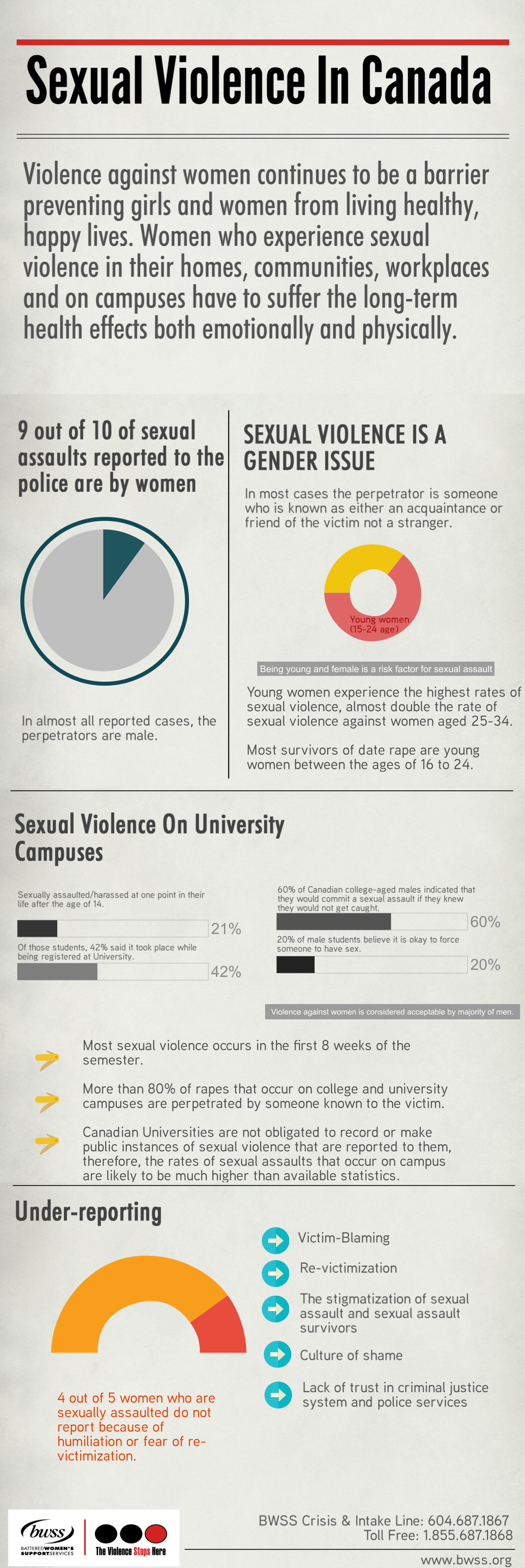Feb 5, 2015 | Battered Women's Support Services
by Rona Amiri, BWSS Violence Prevention Co-ordinator
Violence against women continues to be a barrier preventing girls and women from living healthy, happy lives. Women who experience sexual violence in their homes, communities, workplaces and on campuses have to suffer the long-term health effects both emotionally and physically.


While the majority of incidents of sexual violence go unreported we do know nine out of ten of sexual assaults reported to the police are by women[1] and in almost all cases the perpetrators are male[2]. Contrary to popular belief, in most cases the perpetrator is someone who is known as either an acquaintance or friend of the victim not a stranger. One in five reported cases of sexual assault occurs in an intimate relationship[3]. Moreover, being young and female is a risk factor for sexual assault. Young women (15-24) experiences the highest rates of sexual violence, almost double the rate of sexual violence against women aged 25-34. Young women also have the highest rates of being stalked –usually by someone they know (two-thirds of cases)[4]. Date rape is the most underreported crime in Canada and most survivors are young women between the ages of 16 to 24[5].

Sexual violence on university campuses
Secondary institutions should be safe places where people of all genders are able to learn, grow and engage in the community. Unfortunately, the reality is that Universities and Colleges are places where women face sexual violence. Most sexual violence occurs in the first 8 weeks of the semester[6]. More than 80% of rapes that occur on college and university campuses are perpetrated by someone known to the victim[7]. Canadian Universities are not obligated to record or make public instances of sexual violence that are reported to them, therefore, the rates of sexual assaults that occur on campus are likely to be much higher than available statistics.
A campus survey at the University of Alberta showed 21% of students reported being sexually assaulted/harassed at one point in their life after the age of 14[8]. Of those students, 42% said it took place while being registered at University and over half reported that it happened during their first year of studies[9].
Surveys on male students have shown extremely problematic attitudes to sexual violence. One survey showed that 60% of Canadian college-aged males indicated that they would commit a sexual assault if they knew they would not get caught[10]. Another survey found that 20% of male students believe it is okay to force someone to have sex if they spent money on the date, they were drunk or stoned or if they had been dating for a long time[11]. These attitudes reveal a cultural which we live in where violence against women is considered acceptable by majority of men.
Under-reporting
Information on the prevalence of sexual assault in Canada is limited. It is important to note that these statistics are based on formal police-reported cases of sexual and gender violence. It is estimate that 4 out of 5 women who are sexually assaulted do not report because of humiliation or fear of re-victimization. The underestimation of sexual violence highlights the extent of the problem with sexual violence and a culture that discourages girls and women from speaking up. Incidents of sexual violence are not reported to the police for several reasons. When women do come forward they are frequently blamed for being assaulted, they receive bad treatment or police fail to take evidence. Causing many women to feel humiliated, ashamed, unsafe, and unsupported or fear they will be re-victimized if they report sexual assault. Sexual violence carries a stigma and many girls and women are blamed for their assault. Even those individuals who work in the justice system add to a culture of shame. Police and judges have been reported making ‘victim-blaming’ comments such as that a woman was “asking for” sexual violence based on her clothing. This is unacceptable and creates a climate where girls and women do not feel comfortable seeking justice following a sexual assault.

[1] Statistics Canada. Gender Differences in Police-reported Violent Crime in Canada, 2008. 2010
[2] Statistics Canada. Gender Differences in Police-reported Violent Crime in Canada, 2008. 2010
[3] Statistics Canada. Gender Differences in Police-reported Violent Crime in Canada, 2008. 2010
[4] Statistics Canada. Measuring violence against women: Statistical trends. 2013.
[5] Johnson. H. (2006). Measuring Violence against Women: Statistical Trends 2006. Statistics Canada catalogue no. 85-570-XWE. Ottawa. Retrieved February 16, 2007 from http://www.statcan.ca/english/research/85-570-XIE/85-570-XIE2006001.htm
[6] Department of Justice Canada. Factsheet on Dating Violence. 2003.
[7] Metropolitan Action Committee on Violence Against Women. York University Safety Audit. 2010.
[8] University of Alberta Sexual Assault Centre. A Survey of Unwanted Sexual Experience Among University of Alberta Students. 2001.
[9] University of Alberta Sexual Assault Centre. A Survey of Unwanted Sexual Experience Among University of Alberta Students . 2001.
[10] Lenskyj, Helen. An Analysis of Violence Against Women: A Manual for Educators and Administrators. 1992
[11] Johnson, H. Dangerous Domains: Violence against Women in Canada. 1996.
If you could do something to end violence against girls and women, wouldn’t you?

Aug 30, 2012 | Battered Women's Support Services
by Soraya Chemaly
Stories make our culture and then our culture turns around and makes us. In this way, we teach children how to be and inform the distribution and protection of rights. As it is, we have a world-shaping imbalance in our story telling. Our stories do not teach children that girls and women have independent agency and moral competence. So, why should they grow up to claim them as women or respect them in women as adults?
This is why telling girls’ and women’s stories is important. Every story counts.
Our stories should show that women are UNexceptional and, as such, being a woman is an equally valid way of being human. Flooding the world with our stories challenges the male norms that pervasively define human life. Our media injustice has a dynamic relationship with our human rights injustice.
I am often overwhelmed by women writing to me to express their gratitude for something I have written. Essentially, they are thankful for another woman’s speaking out loud about what so many of us experience. This turns out to be a common experience for many who do what I do. Many women live with feelings of doubt and are alone with their thoughts – thoughts often framed by the shame that many cultures attribute to just being female. Because the realm of women’s lives has been private and mens’ public we have had no positive cultural lexicon that women could share or could place their experiences in the context of. But, now we do. Whether it is a famous model like Christy Turlington talking about the complexities and dangers of giving birth or a writer like Mona Eltahawy asking “Why do they hate us?” or an ordinary person, like runner Anne Valente, writing about how public spaces where harassment is common make the world hostile for girls and women. Your story counts.
If people could say the word menstruation out loud without dying of shame they would be able to understand that women are not pregnant two weeks before conception. Maybe if words for women’s body parts weren’t used as insults, we wouldn’t have legislators that think it’s OK to legislate medical decisions they have no business being involved in. Maybe if people realized that women have always worked, just not for compensation, they wouldn’t say stupid things like making “money is more important for men.” Maybe if people understood that men throw acid that melts people on women, like Sonali Mukherjee they would be less likely to think playing “Beat Up Anita Sarkeesian” is acceptable or funny. And they would stop voting for people who think violence against women is exaggerated. Maybe if people understood that women’s lives have value in and of themselves as opposed to as a means to someone else’s end, they would not be in such a mad rush to sacrifice them. Maybe if people knew that “every German female between 8 and 80” was raped during WWII when the Russians entered Berlin or that girls are being raped to death in militarized zones they would not so defend rape as a source of entertainment or absurd metaphor. Maybe we wouldn’t be on the verge of abandoning American women’s rights for money.
I’ll stop now. Except to say that Girls on Film , which remakes classic movie scenes with women, is one of the best, funniest and creative ways of dealing with this challenge that I’ve had the pleasure to see in a long time.
Also, this is not to discount the amazing work of individuals and organizations, like those listed below to address this imbalance. But, I am tired of hearing, in response to almost anything I write, “Where are the men’s stories? I don’t see any “Men’s sections!”” In general, I don’t like gender binaries – they roundly ill-serve everyone. However, this one is unavoidable: Everywhere in the world our cultural narrative is unabashedly male-dominated. People who ask this question are like fish trying to contemplate water.
In media, as in all areas of leadership, we have a 17% problem. Regardless of what media you chose – or sector of culture including government and business leadership, women make up somewhere between 17-20% of producers and contributors, especially at senior levels and where money and decision making happen. The status of Women in Media, while slowly changing, is incontrovertible. News. Movies and Entertainment. Gaming. History and literature. Magazines. Political narrative. Online communities. School curricula. The number is, mercifully, slightly higheron line. In advertising – a major form of very visible content – 97% of creative directors are men. In movies, 75% of all producers, 80% of all editors, 86% writers, 95% of all directors are men. On screen 77% of all protagonists in top grossing films are male.
The result: We tell every conceivable kind of story about boys and men – . Whereas we continue to shroud the complexity and diversity or women’s life experiences in invisibility, shame and silence.
To be clear, I enjoy men’s stories. Like most women, I learned early to empathize with what it’s like to be male. But this isn’t about men (that’s a SUPER hard concept for some people). It’s about institutionalized sexism and misogyny, millenial narrative imbalance and distortion, and the real social, political and cultural effects of this imbalance. When people say things that reflect a complete and utter ignorance about the reality of women’s lives – their abilities, their bodies, their worries, their ambitions – it is because we haven’t told them, before now, about the reality of women’s lives.
Today, it is especially important to tell specific stories that every girl should know– those that explain that every girl’s and woman’s body is her own and not the property of others or society. This has nothing to do with political affiliation. Stories about our street harassment, rapes, our second rapes, our abortions, our domestic abuse , our risky and frightening pregnancies, our more likely impoverishment, our specific health concerns, our pregnancy-related imprisonments and seizures, our ambivilient motherhoods. We need to talk about the real, tangible effects of EVERYDAY SEXISM. We need to share stories of the entrenched biases we encounter, the subtle sidelining at the hands of condescending benevolent sexists, the male norms that marginalize us and the ways in which we adapt.
To be sure, we have women in stories, and we have men and women telling women’s stories, but consider this:
- First, we continue to tell men’s stories in ways that perpetuate traditional sexist notions of gender. In entertainment media – women are young, ubiquitously sexualized, usually isolated, competitive and objectified – literally made into products. A common ratio is 1-2 females to every 8-10 males and the two women are usually competing. In children’s programming females make up 32% of voices and are four times more likely to have bodies that cannot contain internal organs. Reality TV would be impossible without its backstabbing women. It’s why I argue with my daughters about watching television shows with names like “Gossip Girls,” and “Pretty Little Liars.” We teach children – boys and girls – that women are untrustworthy and morally inept. They are not capable of leadership and are, instead, vain, frivolous, competitive and much worse. This is a classicMiss Representation?
- Second, you’d have to be living under a rock in the Gobi desert to not see how girls and women are sexualized everywhere as objects and products or to think men are treated equally in this manner. The male brain in particular perceives women as objects, not humans, when they are sexualized. The more women are sexualized the more they are seen as animals and the more likely they are to be viewed for their useful, component parts instead of as whole human beings.
- Third, we additionally dehumanize girls and women by dissecting them visually and comparing them to animals. NBC just mastered the art of sexualization and dissection during the Olympics. This is literally the chopping up of female bodies in imagery to focus on valuable body parts. Consider celebrity bump patrols. These are pictures of women’s uteruses. Can you imagine entire magazines filled with dozens of pictures of men’s testicles circled in bright red with headlines like “Can Chris Hemsworth’s sperm breathe properly?” or “Do Justin Beieber’s tighty-whitey’s support his anti-abortion opinions?”
- Fourth, as far as calling women animals, everyone does it. She’s a cougar or a vixen or a fox. Men are henpecked. On and on and on. During a preview for the show “Don’t Trust the Bitch in Apartment 21” in a Loew’s movie theatre Loew’s didn’t want to use the word “bitch” in a voice over after the preview for the TV show, so they changed it to the “family friendly” “girls.” The result was that they taught the 100 plus preteen children in the theatre that “girls” and “bitch” were interchangeable and that in either case they were not to be trusted. Conservative legislators and media excel at endlessly describing women as domesticated livestock. It’s revealing: these animals are docile, dumb, tame. They aren’t threatening, don’t think for themselves and they have sex when the farmer wants them to. They are a consumable resource and ultimately sacrificable. Women of color, on the other hand, get to be rapacious breeding dogs.
- Lastly, we use shallow and misleading euphemisms to hide the ubiquitous threat and actuality of violence against women. Words like “child brides.” We had to have rape tragedies like the abuse of boys by priests and coaches – abuse rooted in perverse understandings of sex, power and gender – in order to point out the fact that media should not be calling rape crimes “sex scandals.” In these ways and more, we glamorize violence against women and allow people with power to lie with impunity in order to cater to outdated “respectable” notions about what types of content and conversation are socially acceptable and “family friendly.”
Why does it matter? Because when girls and women are culturally dehumanized we lose our personhood and our rights are not assured, if we even had them in the first place.
When children grow up immersed in environments that don’t challenge these ideas they grow up to be people who want to “beat the gay” out of their children and seriously believe that rape causes women to internally ooze contraceptives and that rapidly dividing cells has “new life trumps existing life.” They grow up to believe women’s dignity is defined by how they manage their wombs and that women’s rights must be mediated by benevolent father figures because women are ultimately morally incompetent. They grow up to be presidential and vice presidential candidates and nominees, who “absolutely” support these ideas , but do not appear to care about about the implications for real, individual, fully developed human girls and women who don’t conform to their ideals of what makes a female “good.”
The only way any of these ideas persists if you teach people through stories and pictures that girls and women are sub-human abstractions and religious ideals and not autonomous, morally competent human beings with rights.
I believe, maybe naively, that every voice makes a difference and girls and women and like-minded men have unprecedented ways to confront this imbalance. This is why we need to infuse culture with women’s stories. This is why Laura Bates started the Everyday Sexism Project . It’s why Holly Kearl started Stop Street Harassment. Why Ben Atherton-Zemon started Voice of Men (yes, a man and men’s voices in defense of women’s stories) and why you should share your stories openly, without shame or fear.
Women’s Storytelling Resources. This list, in no particularly order, is by no means comprehensive but it is a good start.
Everyday Sexism Project Add your story and use the #Everydaysexism hashtag
Stop Street Harassment
The Astell Project
Women’s Media Center
Name It. Change It.
Women Under Siege Project
Breakthrough (check out their #Imhere campaign)
Black Girls Write
Exhale
Seal Press
Global Girl Media
Lillith Magazine
Scarleteen
Feminist Press
Women’s E-News
Girls Write Now
The Op-Ed Project Byline Blog
The Mamafesto’s Our Reality
Reproductive Justice Blog
Family Values At Work Story Bank
Dancing in the Dark Rape Survivor Blog
Beating Hearts Surviving Domestic Violence Stories
The Experience Project
After Silence
Every Mother Counts
NPRs Storycorp Project
Women in Media and News
The Line Campaign
How to Lose Your Virginity First Person Blog
White Ribbon Campaign
Girls on Film (really – you have to take a look at this)
The Athena Festival
Women, Action and The Media
Media Equity is a tremendous resource.
This article was written on The Huffington Post on 12.04.2012









